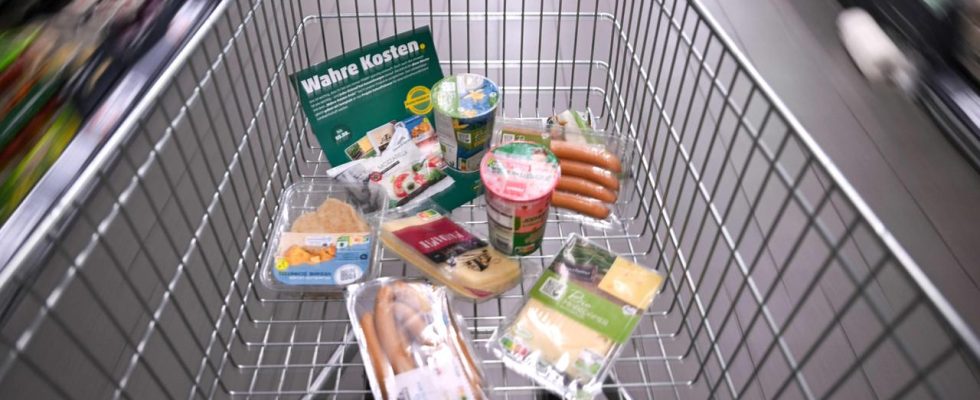For a week, the discounter Penny charged significantly more for selected products. Environmental costs were also factored into the science project. This caused controversial discussions. What’s the balance?
Amelie Michalke from the University of Greifswald and Tobias Gaugler from the Technical University of Nuremberg can actually be happy: not every scientific project in Germany receives as much attention as the so-called “true costs” at the discounter Penny. The fact that it caused such big waves might also show “that we hit a bit of a sore spot,” says Gaugler in retrospect.
Nine foods out of a total of over 3,000 items in the Penny discount store were drastically priced at the beginning of August: four organic and five conventionally produced products. The scientists calculated the so-called “true costs”, i.e. also the effects of production that are normally not paid for by customers at the checkout. Areas such as the environment, water, soil and health were taken into account.
Strong criticism from many quarters
The consequence was a sometimes drastic increase in the price of mozzarella or yoghurt and a vegan schnitzel. As a result, slices of cheese rose in price by up to 88 percent, while the cost of wieners almost doubled. The rise in prices for organically produced food was not quite as dramatic. However, the fact that the environmental costs of food production were shown in a discounter of all places seemed downright absurd even to environmental organizations.
In particular, the supermarket chain Penny came under criticism: Penny belongs to the REWE trading group, competes with the three other big players – Edeka, Lidl and Aldi – for market shares and thus also dictates the prices in Germany. It wasn’t just the social networks that got hot. The whole thing is “greenwashing”, according to the German Farmers’ Association, for example, and the consumer protection organization Foodwatch described the campaign as a pure PR trick.
Penny expected loss of millions
Even if it was only nine selected foods: Penny expects a single-digit million loss in the course of the evaluation of the total of six shopping days – due to the reluctance of consumers to buy these products. But the discounter had expected it beforehand.
Nevertheless, there is also additional income from these foods from the campaign week – i.e. the difference between the conventional sales price and the “true cost” price of the products. She would like to transfer Penny, including a donation, in full to the “Zukunftsbauer” project. Around 375,000 euros are to go to the funding fund, which aims to support family-run farms in the Alpine region with energy-efficient optimization measures.
Evaluation takes months
The research goal for the two scientists is now to break down the established structures in the food sector with the help of a solid data basis. The recorded sales data, feedback and results from qualitative surveys during the campaign week will be included anonymously in a study by the two universities.
Release is scheduled for early 2024. The results should serve as a basis for “so that these external costs do not arise in the first place, that we do not have to pay in the first place, but that the food system is made more sustainable in its entirety,” explains industrial engineer Michalke from the University of Greifswald.
Criticism also of the selection of the products
The Bavarian Economics Minister Hubert Aiwanger (free voters), for example, described it as “discriminatory” that, with the exception of the vegan schnitzel, only animal products were awarded the “real prices”. In the case of milk, cheese or meat products, the upstream feed production is always taken into account in addition to animal husbandry. For unprocessed foods such as vegetables and fruit, the price premium would be less drastic and would usually be in the single-digit percentage range.
The scientists would also like to calculate the “true” prices for a wide range of products – including various plant-based options. “I can understand that one criticizes that this choice was made, which was also made internally by Penny in particular,” says Michalke, “but the message would not have been any different.”
Someone always foots the bill
In principle – and this was somewhat lost sight of in the heated discussion about Penny, discounters and the competitive food market – there are always follow-up costs of production. They are just not paid at the checkout, but are outsourced.
These “real costs” include impacts such as climate change, obesity, child labor and plastic pollution, which are ultimately borne by society or taxpayers. Gaugler sees any inaccuracies in the calculation at most in the cent range, “plus/minus for the decimal place – but the trend statement, especially with CO2, there is scientific consensus that it fits.”
If the scientists had taken a few more factors into account, some price increases would probably have been significantly stronger. Understanding the true cost of food is key to managing risk, driving innovation, and reducing environmental and social costs throughout the supply chain.

